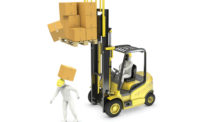Safety tips for forklift truck drivers

A forklift is a powered truck used to carry, lift, or tier materials. The vehicles, also called pallet trucks, fork trucks, or lift trucks, can be powered by combustion engines or electric battery and are extremely useful and time-efficient for completing laborious construction projects. However, they can also be dangerous if not safely and correctly operated. Here are several safety tips that forklift truck drivers should adhere to each time they operate the vehicle.
Ensure you have been fully trained
Thorough training is essential for any piece of equipment that may cause harm to yourself or others, so it is key to be fully confident in operating equipment such as a forklift safely covering British safety standard guidelines. Figures show that forklift accidents happen virtually every week, with 42%[1] of fatalities in the UK involving forklift trucks are due to being crushed by the vehicle tipping over, but around 70% of all UK forklift accidents could be prevented with adequate forklift training.
Check for hazards before operating
Forklift operators should undertake a thorough inspection to ensure the forklift is safe before operation at the beginning of each shift. Steps that should be included within each inspection includes:
- Examine the tires and oil levels
- Check for leaks e.g. water, oil, or radiator leaks
- Ensure forks are straight and not damaged
- Test the brakes, lights, horn, and steering wheel
- Look for obstructions, uneven surfaces, overhead obstacles, and other potential hazards to flag with management
To avoid hazards, equipment such as safety mirrors can be used on the site at blind corners to prevent collisions and protect employees; although they cannot prevent all accidents, with proper use they can reduce the risk of accidents occurring. Side mirrors may also be useful if there are blind spots down the sides of a vehicle.
Make sure each load is balanced and secure
The capacity of each forklift truck will vary. However, it is imperative to never lift loads greater than the capacity of the truck that you are operating. Never move a raised load or a load that appears unsuitable or damaged unless the lift truck is designed for this. A forklift’s load may tip over in the instance where the operator has not inserted the forks under the pallet correctly, so, as well as following the safety rules provided within your company and workplace training, take your time when lifting and depositing loads to avoid errors and injury.
Use floor markings to keep workers safe
To avoid the dangers that forklifts pose to workers within a facility, use floor markings to keep other people safe when operating forklifts in aisles and pathways to ensure that pedestrians and forklifts have separate paths in order to safely contain traffic. Floor signs can also be used to create traffic controls and warn drivers of speed limits, inform pedestrians of nearby forklifts and notify workers when pedestrians or forklifts aren’t allowed in an area. Floor markings are also used to safely reroute pedestrians and create boundaries around forklift parking and charging areas to prevent workers tripping or falling over forks.
With forklift trucks being relied upon throughout the a selection of industries, it is key that all relevant premises and businesses are fully trained, as well as following health and safety regulations on the correct use of forklift trucks in order to prevent injuries within the sector.
Looking for a reprint of this article?
From high-res PDFs to custom plaques, order your copy today!






